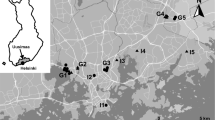Abstract
Forty species of predaceous diving beetles (Coleoptera, Dytiscidae) were collected in sweepnet samples from 98 boreal lakes in northern Sweden. Samples from protected sites with vegetation had significantly more specimens and species than those from exposed sites without vegetation in the same lakes. No geographically based differences, e.g. latitudinal or in distance from the coast, were found. These gradients were 200 and 150 km long, respectively. Species' distribution in terms of occurence at number of sites was positively correlated with the mean abundance of the species. The relationship between species' abundance and body length was characterized by the lack of large, abundant species. Partial least square regressions on dytiscid abundance and species richness showed low predictive power of lake area, altitude and water chemistry. The seven environmental variables used explained at best 15.3 and 24.4% of the total variance in abundance and species richness, respectively. The results are compared to activity trap catches of dystiscids in lakes in an adjacent region. A majority of the species occured in both materials. However, species occuring in high proportion in one of the materials, were rare in the other material. The mean body length of the species caught more efficiently with traps was not larger than that of those overpresented in net sampling. Based on this study and the available literature data, the regional species pool of boreal lake dytiscids is estimated to 30–40 species. It is still an open question if lake assemblages are markedly poorer than those found in the development of vegetation, whereas the impact of water chemistry is small.
Similar content being viewed by others
References
Ahti, T., L. Hämet-Ahti & J. Jalas, 1968. Vegetation zones and their sections in northwestern Europe. Annls bot. fenn. 5: 169–211.
Blackburn, T. M., V. K. Brown, B. M. Doube, J. D. Greenwood, J. H. Lawton & N. E. Stork, 1993. The relationship between abundance and body size in natural animal assemblages. J. Anim. Ecol. 62: 519–528.
Brown, J. H., 1984. On the relationship between abundance and distribution of species. Am. Nat. 124: 255–279.
Hanski, I., J. Kouki & A. Halkka, 1994. Three explanations of the positive relationship between distribution and abundance of species. In Ricklefs, R. E. & D. Schluter (eds), Species diversity in ecological communities. Historical and geographical perspectives. Chicago University Press, Chicago: 108–116.
Hilsenhoff, W. L., 1987. Effectiveness of bottle traps for collecting Dytiscidae (Coleoptera). Coleopt's Bull. 41: 377–380.
Hilsenhoff, W. L., 1991. Comparison of bottle traps with a D-frame net for collecting adults and larvae of Dytiscidae and Hydrophilidae (Coleoptera). Coleopt's Bull. 45: 143–146.
Koskinen, A., 1960. Faunistisch-ökologische Studien über die Wasserkäfer von Saarijärvi (PH), Mittelfinnland. Annls ent. fenn. 26: 173–191.
larson, D. J., 1985. Structure in temperate predaceous diving beetle communities (Coleoptera, Dytiscidae). Holarct. Ecol. 8: 18–32.
Martens, H. & T. Naes, 1989. Multivariate calibration. John Wiley & Sons, New York.
Murkin, H. R., P. G. Abbott & J. A. Kadlec, 1983. A comparison of activity traps and sweepnets for sampling nectonic invertebrates in wetlands. Freshwat. Invertebr. Biol. 2: 99–106.
Nilsson, A. N., 1984. Species richness and succession of aquatic beetles in some kettle-hole ponds in northern Sweden. Holarct. Ecol. 7: 149–156.
Nilsson, A. N., 1986. Community structure in the Dytiscidae (Coleoptera) of a northern Swedish seasonal pond. Annls zool. fenn. 23: 39–47.
Nilsson, A. N., J. Elmberg & K. Sjöberg, 1994. Abundance and species richness patterns of predaceous diving beetles (Coleoptera, Dytiscidae) in Swedish lakes. J. Biogeogr. 21: 197–206.
Nilsson, A. N. & B. W. Svensson, 1994. Dytiscid predators and culicid prey in two boreal snowmelt pools differing in temperature and duration. Annls zool. fenn. 31: 365–376.
Ranta, E., 1985. Communities of water-beetles in different kinds of waters in Finland. Proc. Acad. nat. Sci. Philad. 137: 33–45.
Rasmussen, J. B, 1988. Littoral zoobenthic biomass in lakes, and its relationship to physical, chemical, and trophic factors. Can. J. Fish. aquat. Sci. 45: 1436–1447.
Ter Braak, C. J. F. & I. C. Pentice, 1988. A theory of gradient analysis. Adv. ecol. Res. 18: 271–313.
Author information
Authors and Affiliations
Rights and permissions
About this article
Cite this article
Nilsson, A.N., Söderberg, H. Abundance and species richness patterns of diving beetles (Coleoptera, Dytiscidae) from exposed and protected sites in 98 northern Swedish lakes. Hydrobiologia 321, 83–88 (1996). https://doi.org/10.1007/BF00018680
Received:
Revised:
Accepted:
Issue Date:
DOI: https://doi.org/10.1007/BF00018680




